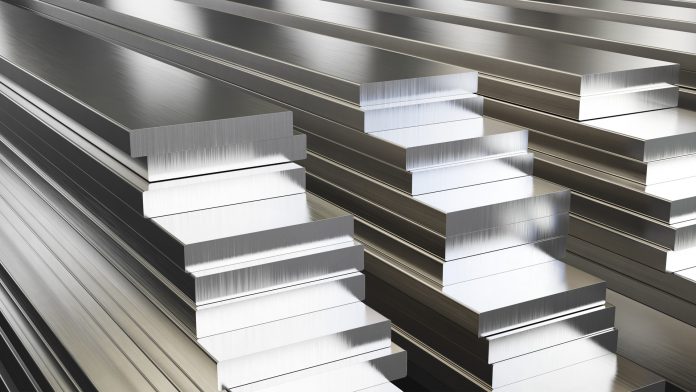Professor Aude Simar’s team at the Université catholique de Louvain are using friction stir processing to enhance the durability of high strength aluminium alloys.
Materials impact the environment, society, and economy. It is thus no coincidence that ‘advanced materials’ and ‘advanced manufacturing’ are considered to be two of the six broad Key Enabling Technologies (KETs) that the European Commission has prioritised for research support. In terms of market budget, 64% of private sector research involves advanced manufacturing, and 32 million jobs (in 2019) in Europe. This represents one in 10 of all companies involved in non financial business in Europe.
Aluminium alloys are of great interest for many applications due to their excellent strength-to-weight ratio, in particular with the advent of high strength aluminium alloys. The aerospace industry has devoted many efforts to support the aluminium production industry, and research around the world aims to develop these higher strength alloys. This is in line with the need for a drastic decrease in fuel consumption in order to mitigate climate change. In addition, the flourishing aerospace industry delivers jobs and boosts economic activity and the discovery of space.
Extending the ductility of high strength aluminium alloys
The attainment of both high strength and ductility – the ability of a material to bend or deform before breaking – is a vital requirement for most metallic alloys. Unfortunately, these two properties tend to be mutually exclusive. Indeed, a high strength leads to an earlier nucleation of damage and earlier failure under excessive loading.
Simar started her research career at the Université catholique de Louvain in Belgium, studying the strength and ductility of high-performance aluminium alloys welded using a new solid state process called ‘friction stir welding’. During this process, a rotating tool mounted on a milling machine penetrates the material and stirs it. Two aluminium plates can thus be welded without reaching their melting temperature. The metallurgical quality of the joints is excellent. Simar noted that the centre of the weld had exceptional mechanical properties when compared to non-processed high strength aluminium alloys.
Following this, Dr Florent Hannard made a more in-depth study of the behaviour under friction stir processing (FSP) of medium strength 6xxx series grade aluminium alloys (Al-Mg-Si alloys). Friction stirring these alloys reduces their initial porosity, which can result from the hydrogen present in the wrought alloy during industrial processing. Such defects are initiation sites of earlier failure in aluminium alloys; therefore, removing them inevitably leads to the improvement of damage resistance and ductility.
Friction stirring the alloy also breaks the large iron-rich intermetallic particles, postponing their fracture under excessive loading. These iron-rich intermetallic particles are the result of the unavoidable presence of iron in the bauxite ore used for the production of aluminium alloys. Drastically reducing their proportion would be too costly in the aluminium production chain. During excessive loading, these particles break due to their brittle nature, but breakage can be delayed if these particles are already broken and re-distributed by friction stir processing.
This concept was applied to the 6056 aluminium alloy, which is commonly used for aircraft fuselage. The deformation at fracture of this alloy under tensile loading was increased by 200%; and the bending angle of the alloy, before any cracking was observed, was significantly increased after friction stirring the aluminium plate.
The strength of 6xxx series aluminium alloys is reduced during FSP. Matthieu Lezaack and Simar rose to the challenge of applying this concept to the highest strength aluminium alloys of the 7xxx series (Al-Zn-Mg alloys), with strength in the range of 500-600 MPa. Here, after friction stirring, the strength also decreases. It can be recovered by an appropriate heat treatment, restoring the fine precipitation that provides the strengthening effect. However, microstructural changes known as abnormal grain growth are evidenced during heat treatments and may be the root cause of catastrophic failure.
Lezaack has managed to avoid this phenomenon and is now able to take advantage of the high strength of the 7475 aluminium alloy combined with an unprecedented deformation at fracture increased by 175%.
In addition to being able to form the sheets locally without risk of cracking, other benefits of this improved ductility may be envisioned. For example, the resistance to crash, like the ones due to bird strikes in airplane fuselage, is expected to be significantly enhanced.
Extending the life of 3D printed aluminium alloys
3D printing has great potential for aerospace applications. It offers the opportunity to redesign parts exploiting topological optimisation, and the use of material is optimised without worrying about the necessity to manufacture them by classical forming followed by machining processes. Laser Powder Bed Fusion (L-PBF) is slowly becoming the reference process for 3D printing aluminium alloys. Note that Selective Laser Melting (SLM) remains a rather common trade name for the L-PBF technology. It consists in building a part layer by layer by selectively melting the aluminium powder.
Aeronautical structures are subjected to repetitive loadings following takeoff, inflight, and landing cycles. These loading cycles are known as ‘fatigue loading’ and can lead, even without excessive loading being reached, to cracking and finally to the failure of critical parts. Despite the interest in 3D printing for manufacturing aeronautical parts, their market penetration is restrained by the low fatigue life of 3D printed aluminium alloys. This is due to the excessive porosity in these alloys, a consequence of unavoidable manufacturing defects and moisture dissolution during the alloy melting.
To reduce the porosity, Juan Guillermo Santos Macías and Lv Zhao have applied post-LPBF friction stirring. Similar to what their colleagues had observed on 6xxx and 7xxx series wrought aluminium alloys, they found a significant improvement in the ductility of the L-PBF AlSi10Mg alloy after FSP. This has been attributed to the reduced Si network connectivity after the process. More interestingly, they have shown that the reduced porosity after FSP could improve the life under fatigue loading of the alloy by two orders of magnitude (from 105 cycles to no failure after 107 cycles under tension at 250 MPa). This process can thus be applied locally, in regions of stress concentration more prone to fatigue failure.
Currently, Simar’s team is working on applying this strategy to Al-Zn-Mg aluminium alloys to further push the performances of aluminium alloys and to avoid compromising between strength, ductility, and durability.
To support this research, a starting grant from the European Research Council (ERC) was awarded to Simar in 2016 for the ALUFIX project. Such projects have also been supported by collaborations with INSA Lyon (France), UAntwerpen, and KULeuven (Belgium).
Professor Aude Simar
Assistant Professor
Institute of Mechanics, Materials and Civil Engineering
Université catholique de Louvain
+32 10 47 35 65
aude.simar@uclouvain.be
Tweet @UCLouvain_be
https://uclouvain.be/en/research-institutes/immc









